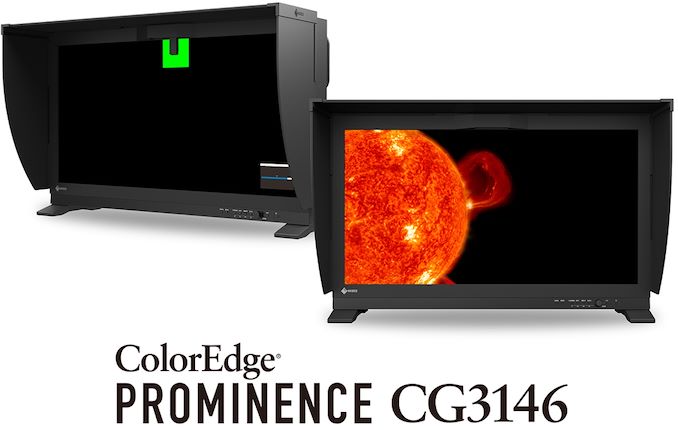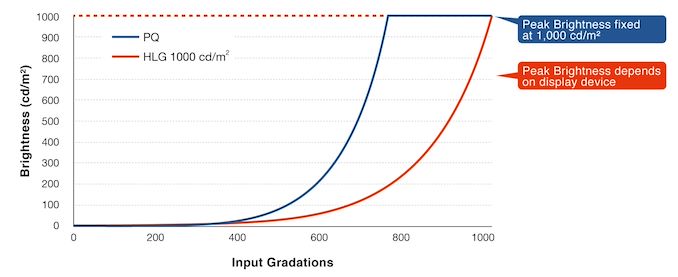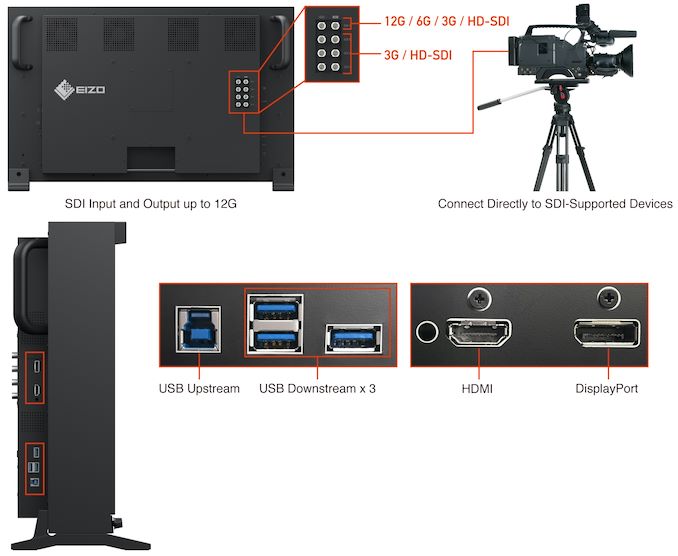EIZO Unveils ColorEdge Prominence CG3146 HDR Reference Monitor with Calibration Sensor
by Anton Shilov on March 2, 2020 2:00 PM EST
Well known for their high-end and reference-quality monitors, EIZO has introduced their latest reference monitor, the ColorEdge Prominence CG3146, which is designed for HDR content mastering for the broadcast and film industries. The new 31.1-inch monitor largely builds upon technologies developed for its predecessor, the CG3145, but has a number of enhancements, including a built-in calibration sensor and SDI connectivity.
The EIZO ColorEdge Prominence CG3146 monitor is based on a 10-bit IPS panel with a 4096×2160 resolution. All told, the monitor can reproduce 1.07 billion colors, and is assisted by EIZO’s proprietary wide-gamut LED backlighting. According to EIZO, the high-end backlighting tech can control backlight intensity on a per-pixel basis, which enables the LCD to display intensively bright colors and deep blacks without the kind of artifacts seen on monitors with coarser backlighting systems. By the numbers, the CG3146 offers a typical brightness of "just" 1000 nits, but also hits a rather whopping 1,000,000:1 contrast ratio.
The ColorEdge Prominence CG3146 covers 99% of the DCI-P3 color gamut and also supports sRGB, BT.2020, and BT.2100 color spaces. The monitor features a 24-bit 3D LUT (look-up table) for smooth color gradations and supports HLG (hybrid log-gamma) and the PQ (perceptual quantization) curve so that it can be used with various HDR modes/transports. For example, HLG’s luminance tops at 1000 nits (which is suitable for TVs), whereas PQ supports considerably higher brightness of up to 10,000 nits, which is required for recorded content.
Color accuracy is absolutely crucial for post production and color grading workloads, so the ColorEdge Prominence CG3146 comes with an integrated sensor that calibrates the monitor when needed and eliminates the need for an external calibrator device. Meanwhile, apart from qualities of the panel and backlighting, it depends on such factors as ambient and internal temperature of the monitor. To that end, the ColorEdge Prominence CG3146 is equipped with a temperature sensor that measures temperature inside the monitor and estimates temperature outside of it to adjust LCD’s settings in real time to ensure accurate colors. Moreover, the EIZO’s digital uniformity equalizer (DUE) technology not only ensures the right luminance, color temperature, and tones for stable image display across the screen, but also counterbalances the effects that a changing temperature may have on uniformity. Last but not least, the display has a light shielding hood.
Moving on to connectivity, EIZO’s new flagship HDR reference display offers an important improvement here. As expected, the ColorEdge Prominence CG3146 has a DisplayPort capable of DCI-4K with 4:4:4 chroma subsampling at 50/60 Hz, as well as an HDMI 2.0 input capable of DCI-4K with 4:2:2 at 50/60 Hz. Furthermore, the monitor has 12G/6G/3G/HD-SDI BNC inputs and outputs to connect SDI supporting devices, which is a huge improvement for the film and broadcasting industries.
| Specifications of the EIZO ColorEdge Prominence Reference HDR Display | |
| CG3146 | |
| Panel | 31.1" IPS |
| Native Resolution | 4096 × 2160 |
| Maximum Refresh Rate | 60 Hz |
| Response Time | 10 ms |
| Brightness | 1000 cd/m² (typical) |
| Contrast | '1,000,000:1' |
| Viewing Angles | 178°/178° horizontal/vertical |
| HDR | 24-bit LUT, various transports |
| Dynamic Refresh Rate | none |
| Pixel Pitch | 0.170 mm² |
| Pixel Density | 149 ppi |
| Display Colors | 1.07 billion |
| Color Gamut Support | DCI-P3: 99% Adobe RGB: ?% Rec. 2020: ?% sRGB: ? |
| Aspect Ratio | 1.9:1 |
| Stand | to be announced |
| Inputs | 1 × DisplayPort 1.4 1 × HDMI 2.0a/2.0b (HDCP 2.2) BNC (12G/6G/3G/HD-SDI) BNC (3G/HD-SDI) 1 × USB-B for monitor control and the USB hub |
| Outputs | BNC (12G/6G/3G/HD-SDI, through-out (active) BNC (3G/HD-SDI, through-out (active) |
| USB Hub | 3-port USB 3.0 hub |
| Launch Date | April 2020 |
EIZO will demonstrate its ColorEdge Prominence CG3146 flagship HDR reference monitor at NAB trade show in Las Vegas, Nevada, in in late April. The company intends to start shipments in April too, but the exact availability timeframe will vary from country to country.
The monitor is covered by a five-year warranty. Though it should be noted that, like other reference monitors based on similar tech, the company is only guaranteeing the monitor's operation for 30,000 hours of usage. The guarantee on brightness and color accuracy, in turn, is even tighter: the monitor's warranty only covers 10,000 hours there, and only when used at a color temperature of 6500K at 800 nits brightness.
Related Reading:
- EIZO Announces ColorEdge Prominence CG3145: 4096x2160, 98% P3 and HDR10
- EIZO Reveals Limited Edition 21.6-Inch Foris Mova OLED Monitor
- ASUS ProArt PA32UCG: The Ultimate Mini LED 4K 120 Hz Monitor with HDR 1600
- ASUS at CES 2019: ProArt PA32UCX 4K Monitor with 1000-Zone FALD Unveiled
- Acer Joins Mini LED Monitor Club with Professional-Focused ConceptD CM7321K













21 Comments
View All Comments
lilkwarrior - Monday, March 2, 2020 - link
That's inaccurate AF. Also note there is far more to HDR than nits. That's an average joe number to get hung up in an oversimplistic "bigger means better" way that just frankly doesn't cut it when evaluating professional monitors.Among the top 10 reference monitors w/ HDR are OLED. That said, pros have multiple monitors representing different display techs for specialized nuance with their grading.
There's no need to be a "fanboy" of a particularly display tech unless you're merely trying to enlighten how it anecdotally made your professional life easier and hope to spread the word for other pros to have similar productivity gains.
Holliday75 - Monday, March 2, 2020 - link
10ms refresh??!?!? Horrible gaming monitor! What garbage.yetanotherhuman - Tuesday, March 3, 2020 - link
Hahahaha, this comment is so terrible I think you gave me cancerlilkwarrior - Monday, March 2, 2020 - link
The USB 3.0 ports are so out-of-place for a modern display like this. It's 2020 for FFS: Use USB4 or Thunderbolt 3.crimsonson - Monday, March 2, 2020 - link
USB is there for low bandwidth peripherals like control surfaces, Wacom tablets, etc.No point in doing TB when far less computers have them.
lilkwarrior - Tuesday, March 3, 2020 - link
You’re not getting the fact that USB4 has TB merged in royalty free & most high-end users this monitor is for use Thunderbolt 3 for vast perf advantages.TB isn’t as prevalent because it was a premium port that wasn’t royalty-free until its use with USB4
lilkwarrior - Tuesday, March 3, 2020 - link
Also note Wacom tablets & etc have moved to USB-C connectors & so on making more practical from a UX perspective that this designer/pro centric device to use USB4crimsonson - Tuesday, March 3, 2020 - link
I didn’t argue about the price of TB licensing. My point is the USB ports on these kind of monitors are intended for low bandwidth peripherals. And wider adoption. Sure TB and USBC might have wider adoption in the future, but not now.If this was targeting Mac users, then that is a stronger argument. If this for Mac, HP, Dell, Boxx, Etc then I don’t think they it’s perfectly fine for USB 3.
Anyway, if you are adding TB on this, wouldn’t make more sense it be the video input port instead of just data?
lilkwarrior - Monday, March 2, 2020 - link
No HDMI 2.1 is a huge turn-off as well; seems an awkward time to release this w/ HDMI 2.1 & Displayport 2.0 right around the corner. HDR1600 would've been nice.cheinonen - Tuesday, March 3, 2020 - link
99% of the time a display like this will be used with SDI. The HDMI and DP connectors are just a "nice-to-have" feature if you need to hook something up quickly, but it'll only be used with SDI in a real-world situation.